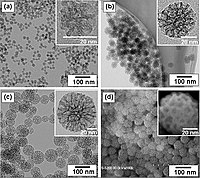
Photo from wikipedia
Upcycling waste plastics into advanced semiconductor photocatalysts provides a new strategy to reasonably and economically solve the huge amount of waste plastics, which however remains challenging. Herein, we synthesize carbon… Click to show full abstract
Upcycling waste plastics into advanced semiconductor photocatalysts provides a new strategy to reasonably and economically solve the huge amount of waste plastics, which however remains challenging. Herein, we synthesize carbon nitride-based donor-acceptor (D-A) conjugated copolymer by copolymerization of dicyandiamide and terephthalic acid from discarded polyethylene terephthalate (PET) using Zn(OH)2 as catalyst and template at 360-440°C. The morphology and structure of the conjugated copolymer are well regulated by the calcination temperature. The resultant conjugated copolymer exhibits merits of high light absorption and low electron-hole recombination probability. Consequently, it works excellently in the persulfate-based advanced oxidation process for visible light-driven photocatalytic degradation of tetracycline. The kinetic constant (3.4 × 10-2 min-1 ) is 40.5 and 2.3 times that of the conjugated copolymer system and persulfate system, respectively. Furthermore, the reactive species (including •OH, SO4 •- , •O2 - , 1 O2 and h+ ) and degradation intermediates of tetracycline are analyzed to expound its degradation process. This work not only pioneers design guidelines on upcycling of waste plastics in a sustainable manner, but also provides a facile strategy to synthesize carbon nitride-based D-A conjugated copolymers for the efficient activation of persulfate-based advanced oxidation process in wastewater treatment. This article is protected by copyright. All rights reserved.
Journal Title: Macromolecular rapid communications
Year Published: 2022
Link to full text (if available)
Share on Social Media: Sign Up to like & get
recommendations!